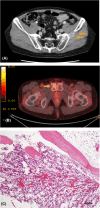Renal cell carcinoma with multiple bone metastases effectively treated by a combination of tyrosine kinase inhibitor, robot-assisted partial nephrectomy, and metastasectomy
- PMID: 38435500
- PMCID: PMC10907337
- DOI: 10.1002/ccr3.8482
Renal cell carcinoma with multiple bone metastases effectively treated by a combination of tyrosine kinase inhibitor, robot-assisted partial nephrectomy, and metastasectomy
Abstract
Key clinical message: Maintaining a disease-free status for a long time in cases of renal cell carcinoma with multiple bone metastases and repeated recurrences is challenging. What matters most in the multidisciplinary approach is the treatment strategy. Although this is a case where multidisciplinary treatment resulted in long-term CR during the TKI era, the treatment strategy is still relevant now that treatment options have increased.
Abstract: Recent advances in medications, such as immune checkpoint inhibitors (ICIs) and tyrosine kinase inhibitors (TKIs), have improved metastatic renal cell carcinoma (mRCC) outcomes. We report a case of mRCC with bone metastasis that was successfully treated using a multidisciplinary approach. Here, we present a case of a 56-year-old man with left renal cancer and large and painful bone metastases at the 11th thoracic vertebrae (Th11). Therefore, a metastasectomy of Th11 was performed. Systemic treatment with TKI, robot-assisted partial nephrectomy, and metastasectomy were then administered. No recurrence was observed in >2 years. Long-term disease-free survival with the TKI-era multidisciplinary approach in a patient with mRCC remains significant when considering treatment sequences, especially now that drug treatment options-including ICIs-have increased. Treatment strategy and indication and timing of resection of the primary lesion and metastasectomy should be carefully considered in each case.
Keywords: metastasectomy; metastatic renal cell carcinoma; multidisciplinary treatment; robot‐assisted partial nephrectomy; tyrosine kinase inhibitor.
© 2024 The Authors. Clinical Case Reports published by John Wiley & Sons Ltd.
Figures




Similar articles
-
Can tyrosine kinase inhibitors be discontinued in patients with metastatic renal cell carcinoma and a complete response to treatment? A multicentre, retrospective analysis.Eur Urol. 2009 Jun;55(6):1430-8. doi: 10.1016/j.eururo.2008.10.021. Epub 2008 Oct 18. Eur Urol. 2009. PMID: 18950936
-
Complete Surgical Metastasectomy of Renal Cell Carcinoma in the Post-Cytokine Era.J Urol. 2020 Feb;203(2):275-282. doi: 10.1097/JU.0000000000000488. Epub 2019 Aug 8. J Urol. 2020. PMID: 31393812
-
Metastasectomy Improves Overall Survival in Metastatic Renal Cell Carcinoma: A Retrospective Cohort Study.Anticancer Res. 2023 Jul;43(7):3193-3201. doi: 10.21873/anticanres.16493. Anticancer Res. 2023. PMID: 37351976
-
Surgical Metastasectomy in Renal Cell Carcinoma: A Systematic Review.Eur Urol Oncol. 2019 Mar;2(2):141-149. doi: 10.1016/j.euo.2018.08.028. Epub 2018 Sep 24. Eur Urol Oncol. 2019. PMID: 31017089
-
Impact of Clinicopathological Features on Survival in Patients Treated with First-line Immune Checkpoint Inhibitors Plus Tyrosine Kinase Inhibitors for Renal Cell Carcinoma: A Meta-analysis of Randomized Clinical Trials.Eur Urol Focus. 2022 Mar;8(2):514-521. doi: 10.1016/j.euf.2021.03.001. Epub 2021 Mar 11. Eur Urol Focus. 2022. PMID: 33714725 Review.
Cited by
-
Metastasectomy for extracalvarial renal cell carcinoma.Clin Case Rep. 2024 Jun 5;12(6):e8967. doi: 10.1002/ccr3.8967. eCollection 2024 Jun. Clin Case Rep. 2024. PMID: 38845800 Free PMC article.
References
-
- Barbastefano J, Garcia JA, Elson P, et al. Association of percentage of tumour burden removed with debulking nephrectomy and progression‐free survival in patients with metastatic renal cell carcinoma treated with vascular endothelial growth factor‐targeted therapy. BJU Int. 2010;106(9):1266‐1269. doi:10.1111/j.1464-410X.2010.09323.x - DOI - PubMed
Publication types
LinkOut - more resources
Full Text Sources

